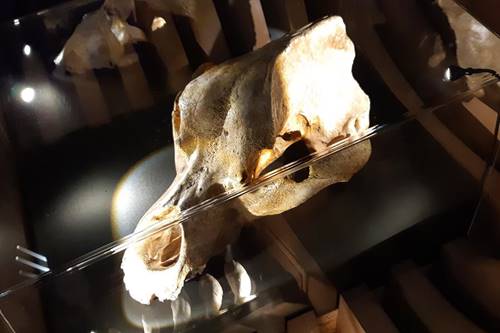New permanent holographic exhibition “Cave – in the darkness of karst underground”
On December 18, 2019, a new permanent exhibition called The Cave was opened in the Natural History Museum of Rijeka – In the darkness of the karst underground.
20.12.2019

20.12.2019
The Rijeka Natural History Museum, as one of the partners in the project KRASn 'KARST, Protection and evaluation of Heritage and the development of sustainable tourism in the karst cross-border landscape within the framework of the project activities of the working package T2 - Protection and promotion of Karst Heritage through interpretation centres and polygons, sets up the Karst intersection, which is a part of the new permanent exhibition.
The newly opened permanent museum exhibition is designed and planned as part of a complete geological exhibition in the museum. Together with the established permanent positions on the theme of the geological past of the Adriatic and the Geology of the Rijeka area, it presents the synthesis of geological research and recent knowledge on karst, the origin of karst, its special characteristics important for our area, sea level changes during the Pleistocene period and former and present subterranean habitats. The new exhibition encircles the geological picture of our area and enables visitors a complete experience, especially of the underground karst forms.
For the first time, the geological exhibition of the Rijeka Natural History Museum was supplemented with items from biological collections, which gave visitors a more accurate and complete picture, thus showing the entire natural history of our region.
The Rijeka Natural History Museum has a large collection of items found in the caves of the Rijeka region. The collection of fossil fauna quarters from the caves of the Rijeka area contains numerous fossil bones and teeth, discovered in 25 caves, which prove a diverse animal community of the pleistocene. The collection includes well-preserved skull of a cave bear (Ursus spelaeus ROSENMULLER & HEINROTH, 1794) found in the cave Sparozna in Kastav, a skeleton of fossil litter bear (Ursus arctos LINNÉ, 1758) found in Banic's cave on the island of Cres, and finds artefacts of palaeolithic and Mesoolithic cultures.
The exhibition shows the cross-section of this rich collection through several thematic units; the ancient life in the cave shows selected lower jaws of various Pleistocene animals found in the caves of the Rijeka region; the story of a frightening vegetarian represents a choice of bone remains and teeth of an extinct cave bear, traces of a prehistoric hunter can be seen of various objects related to the man who sought shelter in the cave. Visitors can explore today's life in karst underground in interactive display cases, while the submerged karst thematic unit explains that during the last ice age the sea level was up to 130 m lower. Ten thousand years ago, decorated rocks were sunk and an incredible relief was created which we recognize today with over a thousand islands. Under the sea are canyons of past rivers, ponds, sunken caves and former hills.
In addition to the author of the exhibition, the curator of the geological and paleontological collection, Nadia Dunato Pejnovic and the director of the Museum, PhD. Zeljka Modric Surina, the head of the Management Department for Culture, Sports and Technical Culture of Primorje-Gorski Kotar County, Sonja Sisic, who praised the initiative to create new museum facilities and expressed satisfaction with the work of the Rijeka natural history Museum.
The restoration of permanent cave installation - In the darkness of karst underground is co-financed by the funds of the European Union and Primorje-Gorski Kotar County.
Source: Fiuman.hr



